The use of boric acid in horticulture: foliar feeding with boron of tomatoes, cucumbers, strawberries and other plants
Boron is a very important trace element for the growth and development of plants, mainly affecting their productivity (yield or splendor of flowering).
Next, we will talk about why plants need boron, how to properly use boric acid as a fertilizer, namely for foliar feeding of vegetable, berry, fruit and flower crops.
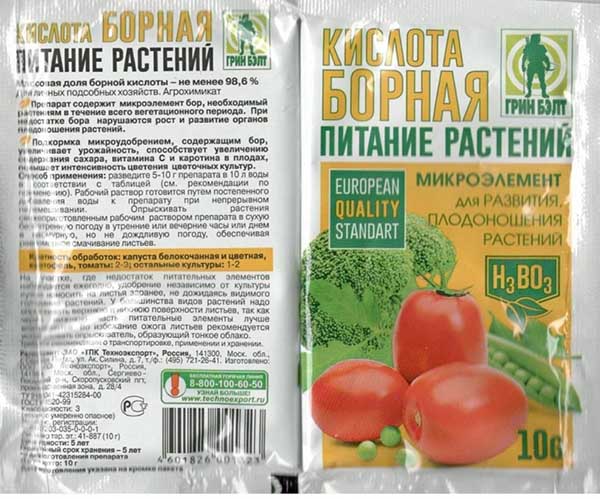
Content
- 1 What is boric acid: composition and scope
- 2 When and how to properly apply boric acid in the garden and vegetable garden: foliar dressing
- 2.1 Terms of application and frequency of treatments
- 2.2 Solution preparation and direct spraying
- 2.3 Is it possible to water the solution under the root (do root dressing)
- 2.4 Dosage and consumption of the solution
- 2.5 What can be added to a boric acid solution to improve its action
- 2.6 Iodine, potassium permanganate and milk
What is boric acid: composition and scope
Boric acid (H3BO3 ) Is a source of boron for plants.
Boron is the most important trace element that takes part in and regulates the processes of pollination and fertilization, carbohydrate and protein metabolism.
In other words, plants need boron during the entire growing season, and not only during the flowering period, although, of course, it is most effective to feed it during flowering.
Note! Crops that are particularly sensitive to boron deficiency are cabbage, beet, tomatoes and apple trees... Boron is also very responsive to feeding. strawberry (garden strawberry).
What happens when there is a lack of boron?
The growth and development of the fruiting organs of plants is impaired (the number of ovaries decreases = yield decreases).
What does foliar feeding with boron give?
Boric acid feeding contributes to:
- increase in productivity (by 20-30%);
Boron is needed for fruit setting.
- an increase in the content of sugar, vitamin C and carotene in fruits;
- improving the intensity of flowering of flower crops;
- prevent irrigation of grapes and beet root rot.
Among other things, boron is responsible for correct absorption of calcium (regulates calcium metabolism).
Thus, thanks to the timely and correct use of boric acid, you will not only increase the yield of many crops, but also significantly increase the quality of products (berries, fruits).
Precautions
Note! Boric acid must be used correctly (in no case exceed the recommended dosages), otherwise boron will not only benefit, but also harm, both for plants and for humans.
The fact is that excess boron may cause burn leaves, necrosis of their edges, and yellowing and dropping.
Moreover, boric acid is quite toxic drugwhich refers to moderately hazardous substances (3rd class of hazard).
Production form
Boric acid is typically sold in garden stores in 10-gram packs.

On sale you can find a specialized drug "Boroplus".

Pharmaceutical (over-the-counter) boric acid will also work for you.
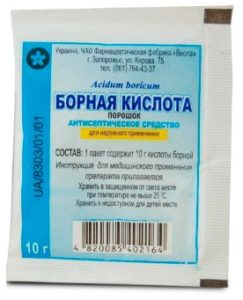
However! It makes no sense to use alcoholic tincture of boric acid.
The fact is that in 100 ml of such a solution there are only 3 grams of boric acid, i.e. you will need at least 150-160 ml of solution, which is equivalent to 5 grams of powder.
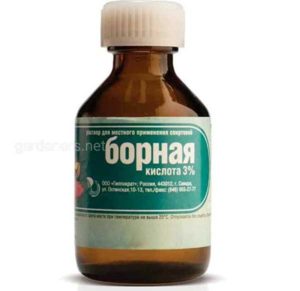
Interesting! Often on sale you can find preparations containing boric acid and gibberellin (a natural plant growth regulator).
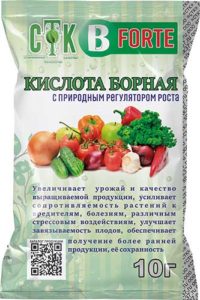
"Mag-Bor" containing also magnesium.
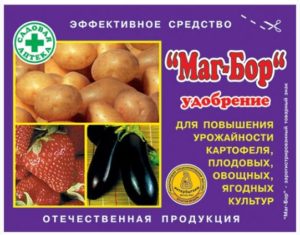
Also, as a source of boron and other useful micro- and macroelements, you can use such fertilizer as “Borofoska«. Only it is better to put it into the soil (on the garden bed, for digging) before sowing seeds or planting seedlings (you can pour it directly into the hole).
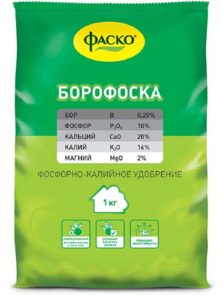
When and how to properly apply boric acid in the garden and vegetable garden: foliar dressing
Most types of soils (especially forest, steppe, sod-podzolic) are poor in boron, in other words, they initially contain a small amount of boron, and from light (sandy) soils it is simply washed out very quickly.
Therefore, if there is a lack of this micronutrient on your site, then feeding with a boric acid solution can significantly increase the yield of your crops.
Terms of application and frequency of treatments
Foliar treatment with boron fertilizer, as a rule, is carried out during floweringas well as before and after.
A couple of nuances:
- Flower crops needs to be processed 1 time in the budding phase (at the beginning of flowering).
- Spraying fruit trees and berry bushes (including grapes) spend before flowering, after flowering and after ovary formation.
Yes, there will be benefits from boron treatment, even if the berries or fruits have already set.
- Cucumbers and tomatoes can be sprayed weekly, so to speak, as new flower brushes appear.

- And here beets it is recommended to treat with boric acid for the first time at the 4-6 leaf stage, then 3-4 weeks later and 2-3 weeks before harvest... The same goes for carrots, root celery and cabbage (unless you need to process 2-3 weeks before harvesting).
Thus, the frequency of treatments is 1-3 times during the growing season (vegetables - 2-3 times, fruit and berry - 1-2 times, flower - 1 time).
Solution preparation and direct spraying
Boric acid working solution for foliar feeding is prepared as follows:
Important! For spraying, you need to choose morning or evening, wherein weather must be dry and windless... In general, processing can be carried out and in the afternoon, if cloudy, but no precipitation (not rainy).
- Dilute 5-10 grams of the drug in 10 liters of water (see the next paragraph for the recommended dosage rates).
Advice! In warm water boric acid dissolves faster.
- Before any feeding (foliar or root), be sure to thoroughly sprinkle the plants with water (so that they are fully provided with moisture).
- Spray thoroughly (top dressing) to ensure uniform wetting of leaves... In this case, it is very desirable to moisten both the upper and lower surfaces of the leaves, as through the lower part the nutrients are better absorbed.
Note! To avoid burning the leaves, it is recommended to use a sprayer that forms thin cloud.
- If you processed by fruits, then the waiting period after spraying is 24 hours (the time after which you can consume the fruits). And of course, the fruits and berries must be washed.
Is it possible to water the solution under the root (do root dressing)
Indeed, almost everywhere it is said only about foliar dressing (spraying). But the boric acid solution is quite suitable for root feeding (watering at the root).
Important! Root dressing should be done only on wet soil, and it is advisable to water it after liquid dressing.
Dosage and consumption of the solution
Boric acid should be used correctly. Obviously, crops have different requirements for boron, and accordingly, the dosages will differ.
- Flower crops (roses, hydrangeas, etc.) - 5 g / 10 l of water. Solution consumption - 1 l / 10 m2.
- Berry crops (grapes, raspberries, Strawberry, currants, gooseberries) - 5 g / 10 l of water. Solution consumption - 1-2 l / 10 m2 (or 0.5-1.5 l per bush).
Vegetable:
- Tomatoes, cucumbers, beet, carrots, onions - 5 g / 10 l of water. Solution consumption - 1 l / 10 m2.
- White cabbage and cauliflower - 10 grams per 10 liters of water. Solution consumption 1 liter per 10 m2.
- Potatoes - 10 g / 10 l of water, solution consumption 1 l / 10 m2.
Treatment of tubers before planting - 10 g / 10 l of water, 1 l / 25 kg.
- Fruit crops (Apple tree, pear, cherry, plum, peach, apricot) 10g / 10 l of water. Solution consumption - 2-10 liters per tree.
What can be added to a boric acid solution to improve its action
Any other fertilizers (zinc, iron, magnesium, succinic acid, potassium humate), growth stimulants, and even fungicides (but not insecticides).
However! It is not recommended to mix boric acid with components that have alkaline reaction.
Sugar for bees
As a rule, sugar is very often added to a boric acid solution (for 5 grams of boric acid - 100 grams of sugar) to stimulate the pollination activity of bees.
Iodine, potassium permanganate and milk
Sometimes on the Internet you can find a recipe for feeding with boron, iodine, potassium permanganate and milk (sometimes even with urea)... This mixture should provide not only good tying, but also protection against fungal diseases + nitrogen saturation (if additionally used urea).
However, there is no point in this tank mixture, besides, urea with potassium permanganate will give very toxic hydrazine, and iodine in low concentrations does not protect from anything.
Recipe from Procvetok Channel
If you want to increase the efficiency of boron feeding, you can use the following recipe from Ivan Russkikh from the YouTube channel Procvetok:
- 100 ml of glycerin (but you can do without it), 5 g of boric acid, a tablespoon of 9% vinegar and 2-3 tbsp. l. ten % ammonia (ammonia) for a bucket of water (10 liters).
Advice! All components can be pre-dissolved in a small volume of warm water, and then poured into a bucket of water.
- Can be used both for foliar dressing and root dressing.
- As for the consumption of the solution, then when irrigating at the root, it is necessary to take into account the provision of soils with boron.
- If this is the first feeding on soils poor in boron, then 1 bucket of solution is needed for 1 adult tree, up to 1 liter for 1 currant bush, from 0.5 to 1 liter for 1 strawberry bush, and up to 0 for 1 tomato plant, 5 l.
- If feeding is done annually, then the doses can be reduced by 2-3 times.
- The shelf life of this solution is unlimited.
Video: boric acid - rules for feeding with boron for tomatoes, apples and other plants
Now you know how to use boric acid as a fertilizer to increase the yield of vegetable, fruit, berry crops, as well as improve the flowering of ornamental plants. Good luck!
Video: boric acid in the garden and vegetable garden


Thank you very much for the information!!!